DVD-Blu-Ray Availability: NONE
You may view the complete version of this cartoon HERE. It has some audio garbage at the start; apologies for the watermarks.
Dailymotion has been acting up lately, but this is the only extant online version I could find (that didn't seem suspicious)...
<><><><><><><><><><>
It may come as a shock to some of you to see a new post here. People have been inquiring about about when I'll be doing the next post on this blog. I'm flattered to know there are folks out there who anticipate reading my two cents on the early works of Tex Avery. Thank you.
Well, since I have a reward in the next cartoon after this, and since my old chum Devon Baxter (whose weekly column on the Cartoon Research website you are reading, aren't you? Hmmm?) offered some guest-commentator notes, I'll saddle up the old bronc and get through yet another Avery unit spot-gag cartoon.
Circus Today is one of the better efforts in this vein--there aren't many spots where I gag--and has some compelling in-jokes. Well, leave us get started...
No narrator! This cartoon opens with an effective use of sound and visuals to convey the setting and mood. Don Brodie* gets us in the proper festive spirit as a carnival barker, spiels over this lovely circus artwork...
...and dissolves to the barker drawing a crowd. This is a significant step up from the prior spot-gag cartoons. Though Robert C. Bruce's tolerant, bemused narrative voice works well in the earlier cartoons, it's refreshing to see Avery and his writers having enough confidence to let go of that crutch.
Mel Blanc vocalizes as a balloon vendor. He typically takes on several roles in these spot-gag affairs.
What might be a routine bit gains gravity from the precise timing of the vendor's panic when he realizes he's airborne...
The touch of having the coins in the vendor's cashbox spill out adds a subtle oomph to the proceedings. We dissolve to another display of the background artist's talent. You recognize the name of this sideshow attraction, yes?
Devon Baxter: "'Gamer the Glutton,' named after special effects artist A. C. (Ace) Gamer...
"...eats different items (mostly metal);
"...takes a bow and the resounding meal in his stomach can be heard quite clearly...
"...reminds me of the Three Stooges short Men in Black (1934), when [the un-credited] Dell Henderson's stomach is full of medical tools, and the sounds are heard as he moves along...
"What terrible pain Gamer the Glutton has to go through when he passes this junk, since he only swallows it whole without chewing (ouch!)"
Indeed. That after-the-cartoon gag is something that no doubt occurred to some adult viewers of this cartoon.. we dissolve to the standard Avery Unit Swami, seen to great effect in his essential classic Hamateur Night...
He's introduced to us as "Hot-Foot Hogan," in another staff reference. Rich Hogan was a long-lasting writer with Avery's units at Warner Brothers and M-G-M. As with the previous gag, no attempt is made to caricature Hogan... his is an in-name-only tribute.
As Devon Baxter notes: "Of course, the payoff is obvious." But the elegance of the animation, and the sober resolve of the slow movement that leads up to Hogan's first step upon the hot coals, is sublime. It creates a tension that the gag's familiarity can't dispel.
Baxter notes: "During the dissolve, the cel of the Hindu man seated on his chair disappears!" Somebody dropped the ball--or the cel--in the camera department.
Onto our next studio in-joke (they say these things come in threes). This time, the name and caricature are intentional and recognizable...
Devon Baxter: "A caricature of director/animator Bob Clampett... I imagine the studio screening of this cartoon got a bigger laugh (in this scene) than in the theatrical distribution..."
The schnozz, chin and glasses are spot-on. Alas, the crash helmet obscures the Clampett pompadour, which was well-caricatured elsewhere in Warners cartoons.
Again, careful, sober film-making wrings a modicum of tension from a thoroughly familiar situation.
In Avery's universe, the world is a small or large as it needs to be, to suit the effectiveness of the gag. It takes Cannonball Clampett about five seconds to go 'round Earth...
Baxter: "...when he lands, there are global stamps on his posterior (because why not there?)"
One trait shared by Avery and Walt Disney, two polar pillars of animation ambition, is the love of "fanny gags." Bites-to-the-ass become a recurring trait in Avery's M-G-M cartoons.
We move next to the menagerie, as Brodie's barker informs us of the venue change.
The old "do not feed the animals" routine gets a welcome twist here. As Devon Baxter notes, this is a reprisal of a gag used in two earlier cartoons, A Day at the Zoo and Cross Country Detours.
"The payoff is better here," Devon rightly notes. "The timing and animation--as well as Mel Blanc's vocal readings of the monkey--really sell the gag." Devon feels that this scene is animated by Rod Scribner--"the timing's there."
"The payoff is better here," Devon rightly notes. "The timing and animation--as well as Mel Blanc's vocal readings of the monkey--really sell the gag." Devon feels that this scene is animated by Rod Scribner--"the timing's there."
The small details in the animation--which plays in a medium shot, with finite areas of the screen involved--sell the joke splendidly. We're expecting the standard "Say, bud, can't you read?" bit, but we get something else...
The monkey's cries of "Help! Police! Law-breaker!" are quite amusing...
... as is the "look, I got him!" expression as we dissolve to the next gag.
In a joke that means nothing to anyone born after 1965**, a stork receives a phone call from comedian Eddie Cantor, "pesterin' me for a boy." The animation is attractive and elegant, though the gag is too topical to relate to more than 0.0000000000000099% of mankind in 2018.
Another gag that modern viewers can anticipate by a long shot, redeemed by superb animation, is this bit with a gorilla, which Brodie's barker describes as "...a ferocious, bone-crushing, man-eating, snarling, growling 2,000 pounds of hate!"
You know the ape will break character and reveal itself as benign. Instead of the typical limp-wristed fey bit, the gorilla adopts radio favorite Bert Gordon's "Mad Russian" catch-phrase...
"How do you doooo..."
...and then gets all bashful-like.
Scenes such as this show how fast animation was maturing. Such work as this would've been unthinkable five years earlier. Disney's short subjects of 1934 and '35 show his staff struggling to depict human or humanoid characters as anything beyond rubbery, good-natured ciphers.
The animators of the mid-'30s were trying just as hard, but the graphic expecations weren't as high as they became by decade's close. Circa 1935, this gorilla would have been constructed of circular shapes, with an over-bearing symmetry. It would've still done the trick, but not for a moment would the work have any genuine gravity or drama.
Through solid drawing chops, including an understanding of dimensional movement, this gorilla, whose screen time is mere seconds, conveys every aspect the narrator raves about. Even though it's all a joke, there is substance behind it, and it's impressive.
We're introduced to the acrobatic team of The Flying Cadenzas. Their dogged literalness is genuinely funny.
This scene relies on animation and music to get its ideas across--no narration would have helped. The unusually small moving figures are impressively handled. No commentary needed from me...
After this dose of gallows humor, some rotoscoped cheesecake is called for...
This "dainty little darling of the saddle," Miss Dixie Dare, attempts to snatch a handkerchief from the ground with her teeth while on horseback.
Yep, it's the ol' dentures gag.
After a fresh start, Circus Today is getting settled into the old Avery game of deliberately corny, elderly jokes that are funny 'cos they're not funny. What's next?
More equestian antics with "Madam Trixie and her dancing horse."
Hot version of "Sweet Georgia Brown" causes the horse to engage Madam Trixie as his hoofing partner. As Devon B. notes, Madam Trixie's bewildered expression helps sell the gag.
Most impressive is the animator's knowledge of perspective and contour. This scene is not rotoscoped, and couldn't be. This is cartoon art, not an imitation of life. The horse does a 360 degree turn while in constant motion. It's masterful work, and it retains character and attitude while navigating this brutal visual trajectory. It can be easy to take classic animation for granted, but moments like this inspire the utmost admiration for these artists who did their work the hard way, without computer assistance or a how-to book...
Most impressive is the animator's knowledge of perspective and contour. This scene is not rotoscoped, and couldn't be. This is cartoon art, not an imitation of life. The horse does a 360 degree turn while in constant motion. It's masterful work, and it retains character and attitude while navigating this brutal visual trajectory. It can be easy to take classic animation for granted, but moments like this inspire the utmost admiration for these artists who did their work the hard way, without computer assistance or a how-to book...
A satisfying one-upmanship gag comes next, as Captain Clyde Bender does the old head-in-lion's-mouth routine...
That ah-ha moment...
The justness of this gag reflects the America it which is was conceived. The put-upon lion gets his rightful share of applause after being the white man's stooge. New Deal Humor at its finest!
This elephant bit allows the re-use of two pet Avery gags... he was inordinately fond of the little-guy-in-the-middle bit. To his credit. he throws in a surprise at the end of the elephant train.Elephant trainer Ignatz Ignatzovich will endeavor to allow the elephant to place its weight of "13,876 tons (!)" on his head.
Elephant breaks down into the "I can't do it" crying fit... familiar from earlier spot-gag cartoons, but still funny nonetheless.
Mel Blanc previously did this routine in Avery's Cross Country Detours--a recent enough cartoon that theater audiences might've had a deja vu moment.
For the final gag, Avery puts his skills as a film-maker to the test. Though he does lean on narration to set up the sequence, he conveys what's happening off-camera through the actions and reactions of a few witnesses. There are moments of Ernst Lubitsch-level subtlety here... the bandmaster bending backwards to watch the summit and dive of the daredevil, Count Boris Sleepoff.
There's no way to have curtains on a circus performance area, so why not different-colored robes?
As the barker barks about the death-defying 5,462-foot leap into a small barrel of water, Avery gives his background artists and layout artists a workout...the long pan to end them all, with a perspective bend in the middle to fool the eye as the camera pans, pans, pans...
The camera pans down again, to reinforce the gravity of this feat.
The circus band breaks into "Over the Waves..."
Well-chosen vantage-points on the upward climb increase its drama.
The band-master's absorption in the climb is comical but highly effective in conveying information to the viewer.
Bandmaster sees that the Count has reached the summit point...
...and instructs the drummer to let 'er roll.
If Avery hadn't used the "I can't do it" bit earlier, he might have let that end the cartoon...
but he's playing it straight.
The downward motion of the band-master's head tells all. There are no sound effects to clue us in...just his subtle changes of expression and body language.
"Okay, Joe... take it."
A sad-faced trumpeter removes his band hat...
...and plays "Taps" as we iris out.
Circus Today makes no real innovations, but finds Avery and his team more assured about being funny. Avery can't quite shake the crutch of the narrator, but the strength of his visual comedy here--it can be seen from the still frames, without watching the cartoon (tho' I encourage you to)--is arresting, and foreshadows some of the finer moments in his next cartoon, which was an earth-shaker and game-changer for Hollywood animation. Avery and his staff were more than up to the challenge, and A Wild Hare delivers the goods with supreme confidence and finesse.
To make a cartoon as good as A Wild Hare required experience, and these spot-gag cartoons, though occasionally tiresome, gave Avery's animators enough variety, challenge and practice to have made enormous strides in a few years. The director's sense of timing and his knowledge of film technique have also gained sophistication since the debut cartoon in this series, The Isle of Pingo Pongo. The grandstanding of the 1937 and '38 cartoons has mellowed. In its place is a poker-faced approach that still prizes table-turning and surprise, but deals its cards with a slyer, smarter hand.
I've been patiently waiting to get to A Wild Hare, and look forward to commenting on it, medical issues nonwithstanding. For those of you that don't know, I'm undergoing a second treatment for non-Hodgkins lymphoma, and will be having a bone marrow transplant in mid-April.
Thanks again to Devon Baxter for his comments and observations!
_______________________________________
* Voice artist historian and all-'round nice fellow Keith Scott confirms that it's Don Brodie. IMDb lists Eddie Marr as the voice artist, but he doesn't seem to have any other animation credits during the time period.
** Film and animation historians, of course, care about who Eddie Cantor was, and enjoy his starring roles in films such as Palmy Days (1931) and Kid Millions (1934). The reference, to most people, is a head-scratcher, or a moment for an explanation that will mean nothing to them in the long run. And that's the nature of the passage of time.
UP NEXT: The wabbit that changed the woild, Doc...







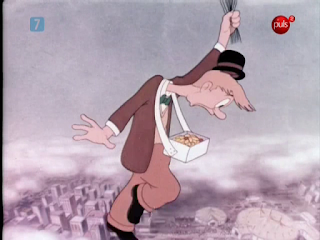
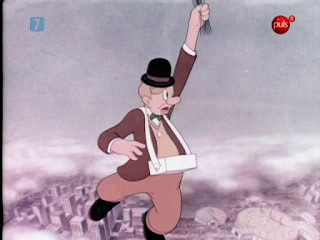







































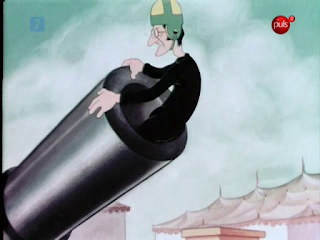


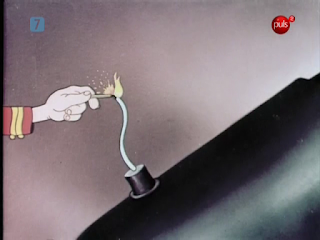














































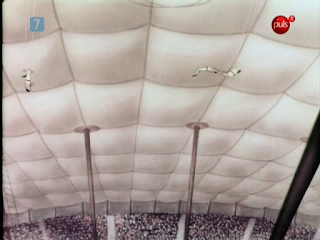















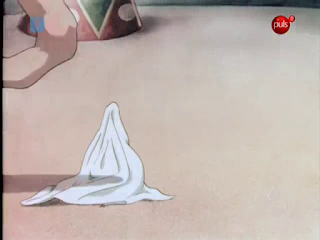







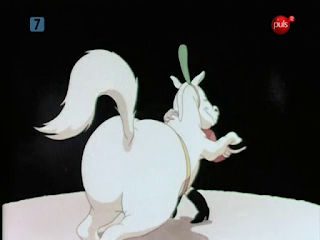



















































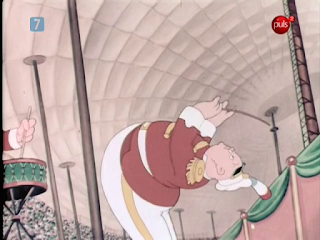





















Avery himself plays the bandmaster (the character design also functions as another caricature in this picture, expect with cuter features and a bald dome) ..
ReplyDeleteThe spot gag shorts aren’t too bad when there is variety to them, especially, as you stated, how narration is executed. The “Flying” Cadenzas joke is so ridiculous it’s funny. I consider this one to be the last decent spot gag short, before they really became tiresome. Although Avery’s final ones before leaving the studio had some interesting moments.
ReplyDeleteGood luck with the upcoming treatment -- you get get to Tex and his bunny when you have the time.
ReplyDeleteOutside of Captain Clampett's round-the-world trip, "Circus Today" is a very slowly paced Avery effort, but the slow pacing does fit the mostly-human cast, as well as showing off the ever-improving animation at Warners (and especially in Tex's unit, where the Robert McKimson-for-Robert Cannon swap with the Jones unit would have just occurred, after Avery acquired Cannon from the Clampett unit to replace Paul J. Smith. The steps up in draftsmanship and looseness in the animation will really hit home starting with the next cartoon).
Excellent work, Frank! (And Devon.) I enjoyed this entry very much.
ReplyDeleteI apologize you for the watermarks and audio garbage, when I was syncing the Original audiotrack from a.a.p. print into the EU print recorded from TV Puls 2. Cool review as always.
ReplyDeleteNo apology needed, sir! It's perhaps the nicest print of this cartoon one could hope to find at present. The colors are a bit muted, but it has a really clean image. Made for good screen captures, as you can see. Thanks for posting it!
Delete